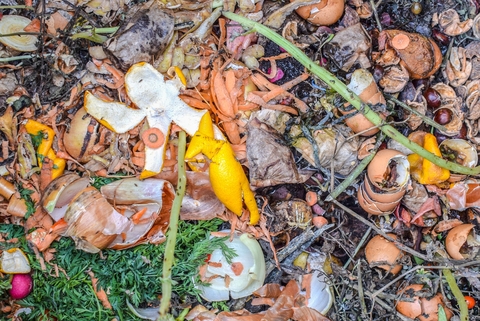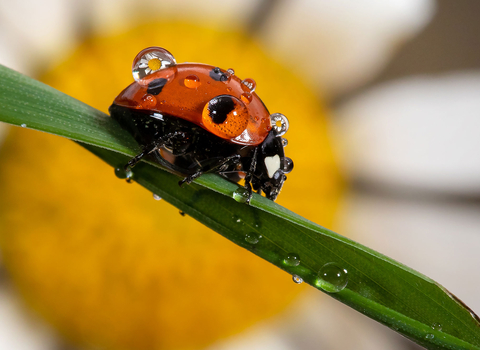Taking action for insects
In the UK, our insect populations have suffered drastic declines, which are set to have far-reaching consequences for both wildlife and people.
Our gardens are miniature ecosystems. By avoiding chemical control and attracting a rich diversity of bug life, we can help halt the decline of insects and help animals such as hedgehogs, frogs, toads and slow worms along the way.
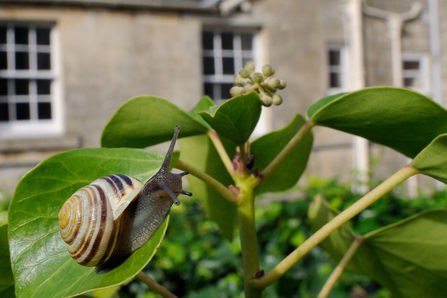
© Nick Upton/2020VISION
Beneficial insects
For a successful wildlife garden, it is best to adopt a ‘live and let live’ philosophy, which means allowing a balance of insect species to exist for their mutual benefit. Below are a list of desirable garden predators and how to attract them.
Pollinators
All insects help with pollination, but some – such as bees and hoverflies – are particularly good at transferring the pollen from flower to flower. This helps fruiting plants, and with setting seed.
Predators
Ladybirds, wasps, lacewings and hoverflies are natural predators of other garden insects such as aphids, mites, and mealy bugs. Their larvae are particularly voracious feeders.
Plants that attract hoverflies include: Phacelia tancetifolia, poached egg plant, michaelmas daisy, sedum spectabile and candytuf, angelica, teasel and scabious.
Prey
Insects provide a source of food for many our much-loved garden visitors including robins and hedgehogs.
Parasites
Parasitic insects, such as the tiny tachnid flies and some species of wasps, lay their eggs directly into the host insect; the developing larvae feed within it, finally emerging, leaving the host for dead.
Creating a home for insects
To help insects thrive throughout the year you need to create spaces where they can live, feed and breed and which help them to move around more easily.
Allow ‘insect safe’ spaces
Cracks in walls, rockery piles and corners of sheds will all provide safe spaces for insects to hide from predators, to breed, and to live during poor weather. You can build a ‘bug hotel’ with a bundle of hollow sticks and bricks or simply create a log pile.
Value dead or dying plant material
Logs, old plant stems, and dried grass are all safe havens for insects to hibernate over winter or take cover in poor weather. Don’t tidy them all away! Stems and seed heads provide important homes for overwintering insects, so don’t cut back or prune unnecessarily.
Choose plants that provide food for insects
Prioritise nectar-rich flowers and choose native locally sourced and grown trees and plants where you can. Nectar rich flowers with a variety of simple structures are best. Avoid double flowered cultivars – these often have less or no pollen and nectar – and throw some herbs and grasses into the mix too! Plan your planting so there is something in flower, leaf or fruit throughout the year, and to include night-scented plants like honeysuckle.
Create a water source
From dragonflies to water boatmen, ponds are important sources of water and nourishment for insects. They don’t need to be large. Even
a small, shallow pebble pond, or upcycled washing up bowl, will be beneficial.
Chemical alternatives
Chemical pesticides don't just kill insects, they will harm the animals that eat them too. This is especially true of slugs and snails, which are eaten by birds, hedgehogs and slow worms. Try some of the chemical free control methods listed below to help create a balance in your garden.
The power of plants
Growing certain plants together can be a pesticide free way to help protect them from insects that eat them or improve pollination of fruit and vegetable crops.
Most companion plants are strongly scented and confuse insects looking for their host plant. Others attract beneficial insects, such as ladybirds and lacewings, which prey on aphids.
Pest repelling plants
Nettles
Leave a patch of nettles in one corner. Not only do they attract peacock, red admiral, painted lady, small tortoiseshell and comma butterflies, they are also a magnet for snails, drawing them away from vegetables and flowers.
Recommended plants to repel pests include:
✓ Tansy
✓ Marigold
✓ Mint
✓ Catnip
✓ Wormwood
✓ Chives
✓ Dill
✓ Fennel
✓ Rosemary
✓ Oregano
✓ Thyme
Other chemical free solutions
Slugs and snails
Slug traps
Buy or make your own slug traps using yoghurt pots buried in the soil around your plants and fill with cheap beer or milk. Ensure the lip of the pot is at least 2cm clear of the soil so that ground beetles cannot get in.
Dig over your soil
Dig over your borders or vegetable plot in winter when the ground is cold and any slugs and their eggs will be exposed and killed or eaten by predators.
Nematodes
Try slug nematodes - a slug parasite that only targets slugs and is harmless to everything else.
Aphids
Spray infested plants with a mild solution of washing up liquid or strong jet of water. Plant nasturtiums in your vegetable plot to attract them away from your produce.
Red spider mite
In a greenhouse use the biological control, Phytoseiulus persimilis, a predatory mite.
Homes for insect predators
A pile of logs in a shady corner and a hibernaculum for reptiles and amphibians make a good home for many of the garden’s welcome guests. Frogs, toads, slow worms, grass snakes, shrews, hedgehogs, ground beetles, centipedes and rove beetles will all use them as homes.
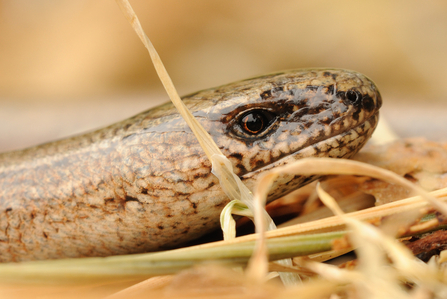
© Amy Lewis
Composting
A compost pile provides an excellent home for a number of beneficial garden residents such as slow worms and beetles, as well as pests, drawing them away from garden plants and flowers. Composting is also a great alternative to buying peat based compost, which is bad for the environment, and a cheap way to restore nutrients to your garden.
Compost bins can be made from old shipping pallets or other timber, or you can buy them from most garden centres or DIY stores. Whatever bin you choose, it must have a rainproof lid that does not blow away and a large top opening that enables you to turn the compost with a fork.
Compost bins do not have a base so excess liquid can drain away. Some bins have a removable front or ’chute’ at the base to allow you to extract rotten compost from the bottom of the heap. Check this is big enough to get a spade easily in and out.
What to compost
Compostable materials include:
- Grass clippings and leaves
- Soft, leafy plants including annual weeds
- Fruit and vegetables and their peelings (except citrus fruits and onions)
- Ground coffe and loose tea or teabags made form natural materials
- Some pet waste/bedding
- Prunings and hedge trimmings (ideally shredded),
- Woodchip
- Leaves
- Paper and card (torn up or shredded)
- Straw
- Plant stems
- Sawdust from untreated wood
- Poultry manure
What not to compost
Avoid putting these waste items in your compost pile:
- Teabags made from synthetic materials
- Meat (unless you are using a meat compatible compost bin)
- Coal ash
- Citrus peel and onions (the acid kills worms)
- Glossy or coated paper
- Sawdust from treated wood
- Large branches or pieces of wood
- Plastics
- Cat litter & dog faeces
- Disposable nappies
- Glossy magazines
How to compost
Turning the heap
Turning your compost heap regularly with a garden fork or spade adds air, which is needed for the process of composting to occur. Aim to turn your compost around once a month.
Moisture
Keep your compost heap moist in dry weather and avoid getting it too wet as this will hamper the composting process.
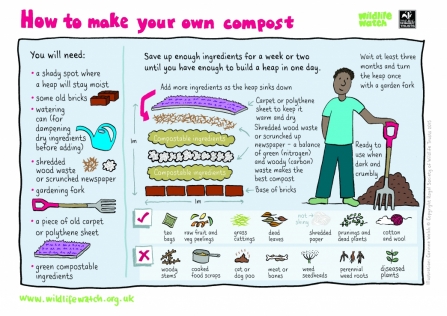
How long does it take?
Garden compost takes between six months and two years before it is ready to use. Garden ready compost will be dark brown, have a crumbly soil-like texture and an earthy damp smell.
Remove any un-rotted material back to the compost bin, to be mixed with your next batch.
